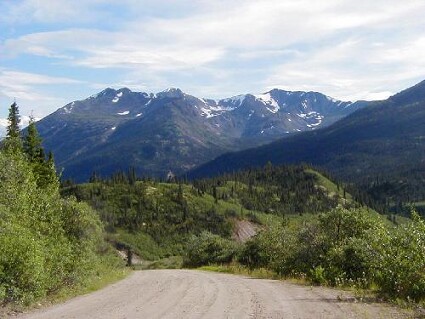 |
 |
|
 |
 |
|
|
 |
Warning:
All persons using the North and South Canol roads should be warned that these roads are never snowploughed in the winter. They are allowed to snow shut in the fall, and thaw in the spring. These roads should not be traveled between the end of September and mid-May. There are also no services along these routes, other than what is available in Faro, Johnson's Crossing and Ross River. You must bring everything you need, as these are true wilderness areas.

Warning:
All persons using the North and South Canol roads should be warned that these roads are never snowploughed in the winter. They are allowed to snow shut in the fall, and thaw in the spring. These roads should not be traveled between the end of September and mid-May. There are also no services along these routes, other than what is available in Faro, Johnson's Crossing and Ross River. You must bring everything you need, as these are true wilderness areas.
 Canol Road (Yukon Highway 6) - beskrivelse 
The 513-mile-/825-km-long Canol Road (Yukon Highway 6) was built to provide access to oil fields at Norman Wells, NWT, on the Mackenzie River. Conceived by the U.S. War Dept. during WWII, the Canol (Canadian Oil) Road and a 4-inch-diameter pipeline were constructed from Norman Wells, NWT, through Macmillan Pass, past Ross River, to Johnson’s Crossing on the Alaska Highway. From there the pipeline carried oil to a refinery at Whitehorse. Only about 1 million barrels of oil were pumped to Whitehorse before the war ended in 1945 and the Canol Project was abandoned. The Canol Road was declared a National Historic Site in 1990.
The Canol Road between Johnson’s Crossing on the Alaska Highway and Ross River on the Campbell Highway (South Canol Road) and between Ross River and the YT–NWT border ( North Canol Road) is open to summer traffic. It is maintained to minimum standards. Services are available only at Johnson’s Crossing and Ross River.  Links  |
|
|
 |